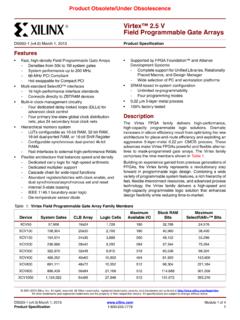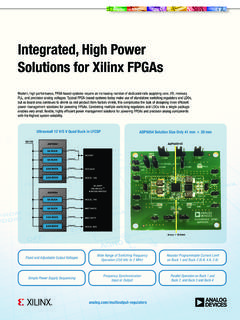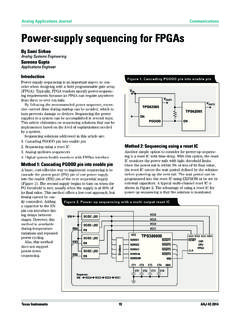Transcription of Product Obsolete/Under Obsolescence …
1 Product Obsolete/Under Obsolescence APPLICATION NOTE. Efficient Shift Registers, LFSR.. Counters, and Long Pseudo- Random Sequence Generators XAPP 052 July 7,1996 (Version ) Application Note by Peter Alfke Summary Shift registers longer than eight bits can be implemented most efficiently in XC4000E Select-RAMTM. Using Linear Feedback Shift-Register (LFSR) counters to address the RAM makes the design even simpler. This application note describes 4- and 5-bit universal LFSR counters, very efficient RAM-based 32-bit and 100-bit shift registers, and pseudo-random sequence generators with repetition rates of thousands and even trillions of years, useful for testing and encryption purposes. The appropriate taps for maximum-length LFSR counters of up to 168 bits are listed. Xilinx Family Demonstrates XC4000E, XC4000L, XC4000EX, XC4000XL Shift registers implemented in RAM.
2 LFSR counters Introduction The XC4000E on-chip distributed synchronous RAM archi- the feedback for those states, the 4-bit LFSR counter tecture lends itself well to the efficient implementation of counts modulo 16, and has no lock-up state. Counters with long shift registers. The 16 x 1 or 32 x 1 RAM behaves like a shorter cycle require additional decoding of the feedback an edge-triggered register. An address counter supplies signal, as shown in Table 1 and Figure 1. Any such decod- sequential addresses, but there is no need for a conven- ing is easily done in the front-end CLB function generator. tional binary address sequence. Any repetitive pattern is For a 5-bit counter, Table 2 shows the connections required acceptable, and a linear feedback shift register counter is for dividing by any number up to 32.
3 The most efficient. In the examples below the conventional LFSR counter algorithm has been modified to guarantee no Table 1: Decoding of Feedback Signal, 4-Bit Counter lock-up, even in the all-ones state. 1234 1234. Note that the established literature describes the outputs of 0000 0110 3. LFSRs as Q1 to Qn (not Q0 to Qn-1, as is customary in binary counters). In order to be consistent with prior litera- 1000 7 0011 11. ture, LFSR bits are therefore labeled 1 to n throughout this 1100 11 1001 9&8. application note. 1110 0100 14. 1111 1010 6. LFSR Counters 0111 13 & 12 0101 2. For a 4-bit counter, the basic XNOR feedback from Q3 and 1011 10 0010 5. Q4 would exclude the all-ones state. By decoding the two 1101 5&4 0001. states where the lower three bits are all ones, and inverting Q4.
4 Q3 A. D1 Q1 D 2 Q2 D3 Q3 D4 Q4. Q4*. Q3. B. Q2. Q1. C. X5801. Figure 1: Divide by 5 to 16 Counter XAPP 052 July 7,1996 (Version ) 1. Product Obsolete/Under Obsolescence Efficient Shift Registers, LFSR Counters, and Long Pseudo-Random Sequence Generators the right of the & symbol, also add Q4 to AND gate B , thus Table 2: Decoding of Feedback Signal, 5-Bit Counter skipping the all-ones state. All of these counters avoid lock- up in the all-ones state. 12345 12345. 00000 11101 13 For 16: do not connect Q4 to AND gate B , do not use AND gate C . 10000 23 & 22 11110 31. For 15: connect Q4 to AND gate B , 11000 7 11111 do not use AND gate C . 11100 19 & 18 01111 15 & 14 For <15: program AND gate C" according to the table 01110 17 10111 29 For 4, 8,12,15: connect Q4 to AND gate B . For all other numbers: 00111 8 11011 6&5.
5 Do not connect Q4 to AND gate B . 10011 12 01101 26. 01001 28 & 27 10110 3 Divide-By 2 to 32 Counter in CLBs 00100 15 01011 11 & 10 Feedback for 32: 00010 11 00101 17 & 16 (Q3 XNOR Q5) XOR (Q1 AND Q2 AND Q3 AND Q4). 10001 9 10010 20 To divide by a number smaller than 31, use AND gate C in 01000 4 11001 25 Figure 2 to decode the binary pattern listed in Table 2 next to the desired number. For 31 and any number listed to 10100 30 01100 6 the right of the & symbol, also add Q5 to AND gate B , thus 01010 21 00110 24 skipping the all-ones state. All of these counters avoid lock- 10101 2 00011 21 up in the all-ones state. 11010 26 00001 31 For 32: do not connect Q5 to AND gate B , do not use AND gate C . For 31: connect Q5 to AND gate B , Divide-By 5 to 16 Counter in Two CLBs do not use AND gate C.
6 For <31: program AND gate C according to the table Feedback for 16: For 5,10,14,16,18, 22, 27, 31: (Q3 XNOR Q4) XOR (Q1 AND Q2 AND Q3). connect Q5 to AND gate B . To divide by a number smaller than 15, use AND gate C in For all other numbers: Figure 1 to decode the binary pattern listed in Table 1 next do not connect Q5 to AND gate B . to the desired number. For 15 and any number listed to Q5. Q3 A. D1 Q1 D2 Q2 D3 Q3 D4 Q4 D5 Q5. Q5 *. Q4. Q3 B. Q2. Q1. X5802. C. Figure 2: Divide by 2 to 32 Counter 2 XAPP 052 July 7,1996 (Version ). Product Obsolete/Under Obsolescence RAM-Based Shift Registers As shown in Figure 3, a 32 x 1 shift register design requires DIN DOUT. two CLBs for the 16 address counter plus one CLB for the 4. 16 x 1. Synchronous RAM. An 8-bit wide, 32-bit long shift register would use RAM.
7 Seven additional CLBs for RAM storage and output regis- ters. Wider and longer shift registers can easily be imple- DIN DOUT. mented using the same concept. For increased length, it is 4. 16 x 1. Synchronous most efficient to divide the length into equal parts of up to RAM. 16 bits each and use a common address counter. 4. Figure 4 shows a 100-bit long, 8-bit wide shift register as an Q4. example. It uses two CLBs to implement a divide-by 16. Q3 D1 Q 1 D2 Q 2 D3 Q 3 D4 Q4. counter, plus 24 CLBs for RAM storage and additional reg- isters. Each bitstream uses three cascaded CLBs with their Q2. RAMs acting as 16+16 bit registers, plus four of their flip- Q1. flops used to bring the total shift-register length to 100. This X5803. design thus emulates 800 bits of shift register in only 26.
8 CLBs, and it can run at a 70 MHz clock rate. Traditional reg- Figure 3: 32 x 1 Shift Register in 3 CLBs ister-based designs would use 5,600 equivalent gates for this complete function (seven gates per register bit). Here it occupies of an XC4010E. Does that qualify the XC4010E as an 86,000 gate device? DIN (8) D Q D Q. 16 x 1 16 x 1 16 x 1. 4 Synchronous 4 Synchronous 4 Synchronous A FF A A FF. RAM RAM RAM. 16 x 1 D Q 16 x 1 16 x 1 D Q DOUT (8). 4 Synchronous 4 Synchronous 4 Synchronous A FF A A FF. RAM RAM RAM. DIN (8) D Q D Q. 16 x 1 16 x 1 16 x 1. 4 Synchronous 4 Synchronous 4 Synchronous FF FF. RAM RAM RAM. 16 x 1 D Q 16 x 1 16 x 1 D Q DOUT (1). 4 Synchronous 4 Synchronous 4 Synchronous A FF A A FF. RAM RAM RAM. 4. A. Q4. Q3 D1 Q1 D2 Q2 D3 Q 3 D4 Q 4. Q2. Q1. X5804. Figure 4: 100 x 8 Shift Register in 26 CLBs XAPP 052 July 7,1996 (Version ) 3.
9 Product Obsolete/Under Obsolescence Efficient Shift Registers, LFSR Counters, and Long Pseudo-Random Sequence Generators Pseudo-Random Sequence Generator in Four CLBs Any long LFSR counter generates a long pseudo-random The conventional shift register implementation of a 63-bit sequence of zeros and ones. The sequence is not exactly LFSR counter requires 32 CLBs in XC3000 or XC4000. random since it repeats eventually, and it also follows a family devices. By using a RAM-based approach, only two mathematically predictable sequence. But for most practi- CLBs are needed, plus the addressing counter, which can cal purposes it can be considered random. be a 15 LFSR counter in two CLBs. With proper partition- ing, the complete 63-bit pseudo-random sequence genera- A 63-bit LFSR counter has a repetition time of (263-1) clock tor shown in Figure 5 requires only four CLBs, and is periods.
10 Running at 50 MHz, such a counter repeats after capable of running at up to 70 MHz. A starting pattern of up more than five thousand years (5,849 years to be more pre- to 63 bits can be first loaded into the shift register, and the cise), which is long enough to be irrelevant for most practi- output then generates a pseudo-random sequence of zeros cal purposes. Conceptually, a 63-bit LFSR counter consists and ones. The design can be expanded to a 127-bit LFSR. of a 63-bit shift register, with an XNOR feedback from the counter in six CLBs, or a 159-bit LFSR counter in seven last stage and the next-to-last stage. (See Figure 5.) The CLBs. Either of these two counters has a repetition period 63-bit length was actually chosen because of its conve- many billion times longer than the life of the universe.











